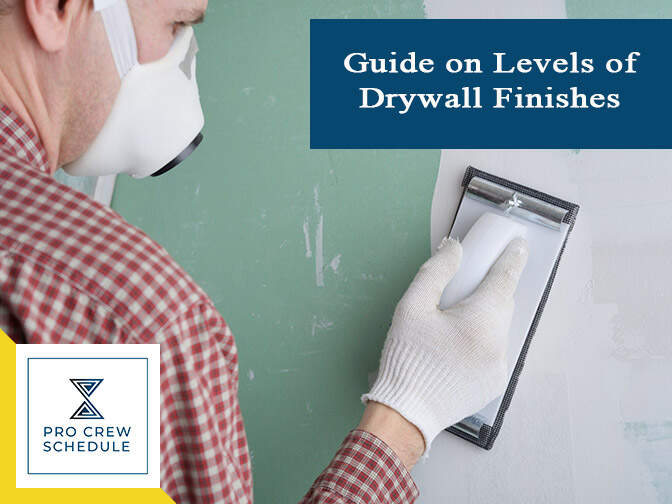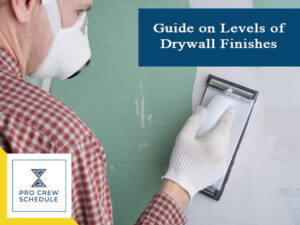Depending on the circumstance, the level of drywall finish necessary can vary in every place. For example, while the house is being built, the client may want to have a fully furnished drywall. There can also be times that a client may want a drywall that is not painted yet because of a shortage in the budget or for design purposes. And there can also be times that a client wants a certain level of “unfurnished” drywall because it will be used temporarily or because it will not be visible to other people, and the client thinks that having it fully-furnished will only be a waste of money. For whatever reason, clients and projects’ preferences and needs can vary, which is why a drywall contractor needs to be familiar with the different levels of drywall finishes so that he or she will be able to easily identify what kind of finish a project needs or a client wants. And on the side of clients, it will also be easier for them to ask for what they want if they know the different levels of drywall finishes.
For some reason, a drywall business or contractor can have numerous projects scheduled within the same month or even week. For this reason, a business or contractor needs to handle many projects at the same time. The specifications and customizations made by clients must be always met. It is also essential that they keep track of what kind of drywall finish a drywall project needs to avoid confusion and conflicts. Furthermore, other than these tasks, a drywall contractor may also have several other tasks such as creating a crew schedule, keeping track of transaction records, crew monitoring, and ensuring that the crew is having an efficient way of communication. But what can be done for a drywall contractor to be able to do all of these things? Currently, there are many builder trends available in different industries that are available and can be easily accessed. Machines, tools, equipment, and project management tools are now present and are already being utilized by businesses. Because of this, businesses are becoming more competent and efficient, and it might become even necessary someday to use these tools for other businesses to be able to stay competitive. One of the builder trends that can help a drywall business or contractor is a project management software like Pro Crew Schedule. With the use of tools such as this, drywall businesses, drywall contractors, and or project managers will easily do tasks such as scheduling and monitoring and saving time.
Level 0:
Just like what was mentioned above, there are different levels when it comes to drywall finish. The first level is at level 0. This is the level wherein there is no finish at all. There is no taping, painting, or joint cement. The only thing available is the drywall that was built. This drywall level is best to apply when the drywall will be temporary or the people in charge are still unsure of the decoration that they want.
Level 1:
The second level when it comes to drywall finish is level 1. At this level, there is still no painting but there is taping. Interior angles and joints will be taped at this level. And the extra materials or parts will also be eliminated during the process of application. But tool marks and ridges can still be visible at this level. This drywall level is recommended for use only in areas that are concealed and not visible to the public, such as service corridors, plenum areas above ceilings, and attics.
Level 2:
The third level of drywall finish is level 2. At this level, the drywall can be used as the final output for places or projects such as warehouses and garages, where how it looks is not seen as something significant. At this level, the interior angles and joints already have tape embedded in the joint compound and is wiped with a joint knife, which will leave a slim layer of joint compound on all the interior angles and joints. At this level tool marks and ridges are still fine, and they are also still no painting. But in comparison to level 1, the taping in level 2 is more extensive is applied in a detailed manner. All of the nails, screws, accessories (fastener heads), and beads are also coated with one compound coat at this level.
Level 3
At Level 3, the tape must be embedded in the compound and another coat of compound on the angles and tape joints. The compound also needs to be smooth and there should be no tool marks or ridges. Moreover, beads ad fastener heads are supposed to have two coats of compound. At this level, it is also recommended to apply a coat of primer for drywall after the process of taping before putting the final decoration. This type of drywall finish is recommended for heavily weigh wall coverings or for a medium up to a heavy final paint texture. Level 3 is not recommended if one wants the final decoration to be of light textures, light to medium weight coverings, or a smoothly painted surface.
Level 4
For level 4 of drywall finish, there will be two new added coats compared to level 3 with an additional coat of compound on the embedded tape at the drywall angles and joints. Also, three separate coats of joint compound are applied on accessories, beads, and fastener heads at this level. Furthermore, at level 4 of the drywall finish, there should not be any ridges or tool marks, and the compound needs to be smoothed. A coat of primer is also applied after the taping process. If the person in charge wants the final decoration to be a light texture, a lightweight wall covering, or a flat paint this kind of finish, or level 4 is suggested.
Additionally, it is advised that when specifying level 4 drywall finish, special observation or regards should be given to large or multiple windows, long corridors, and large areas of walls, because these areas probable areas of concern in reaching admissible wall finishes. It might be necessary for these areas to be specified suitably. Another thing that should be noted about a level 4 drywall finish is that semi-gloss, gloss, and enamel paints are not suggested for use with this kind of finish.
Level 5
The final level of drywall finish is level 5. In this level, all operations that were performed in Level 4 are also required. This kind of finish is advised to be used on areas that are to receive non-textured flat paints, gloss, semi-gloss, and where extreme lighting conditions are present. Other than all of the steps applied on level 4, level 5 is composed of another step: applying a thin skim coat of joint compound especially manufactured for a specific purpose, on the whole surface. The purpose of the skim coat that is being applied on the surface is to hide the little flaws in joints and those on the gypsum board’s exterior to make it look flat by helping conceal the joints. Moreover, a skim coat can also be utilized to lessen the contrast in the porosity of the surface, produce a more uniform exterior where the final decoration can be applied, and smooth the paper’s quality. This level is recommended for non-textured and gloss paints in severe lighting conditions, semi-gloss, and flat paint surfaces with enamel. In the last three drywall finish levels, which are level three (3), four (4), and five (5), the drywall primer was used. This pertains to a high-quality primer and is prepared to even out the suction dissimilarity between the joint compound and the gypsum board surface paper.
Key Takeaways
As to what was discussed above, there are different levels of drywall finish. It is noticeable that every finish uses a specific technique and a different set of materials. Moreover, the final outputs for every level are also not of the same quality and are recommended for varying purposes. These differences also seem to be crucial to the appearance and quality of the drywall. For these reasons, it is essential for drywall crews and contractors to be familiar or even better, knowledgeable about these drywall finish levels for them to be able to perform and provide what their clients prefer and what their project’s needs. This is not the sole thing that they need to do to succeed in drywall making. But to be able to do this well, they need project management tools that can aid them in many of their tasks and will undoubtedly contribute to them becoming more effective and efficient, which will surely help them reach their objectives when it comes to the drywall industry.







